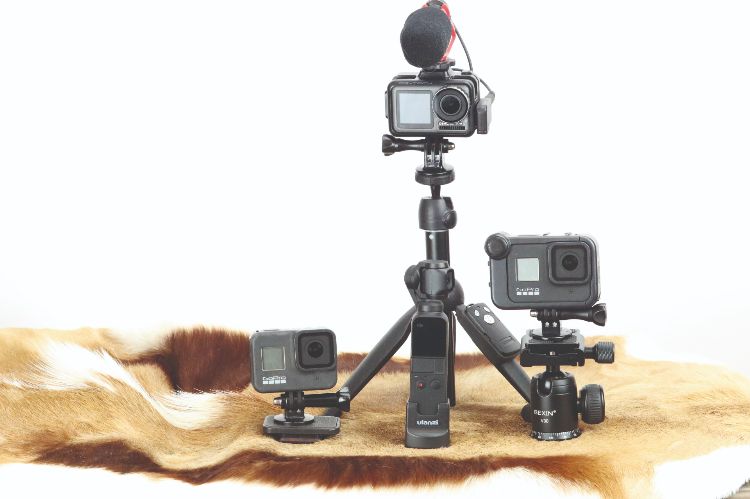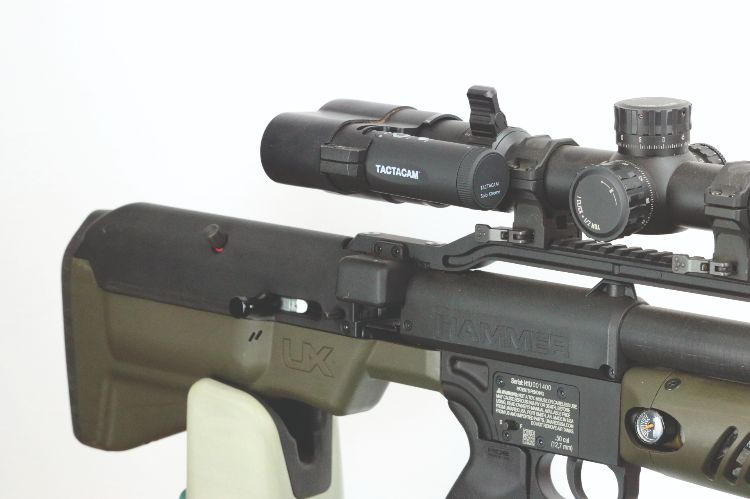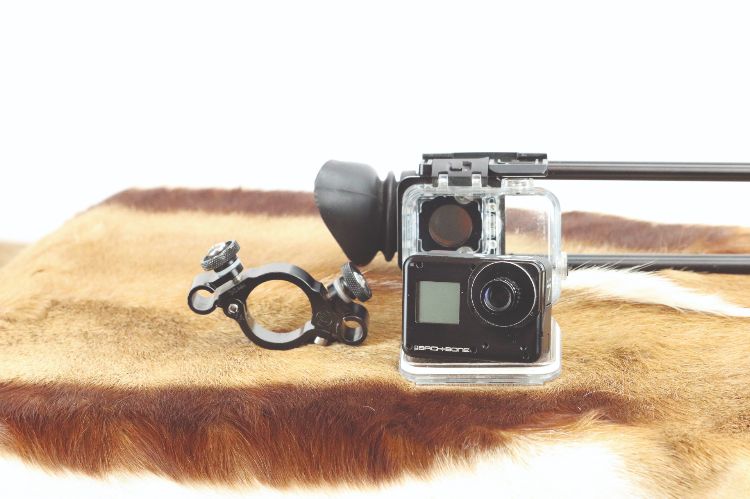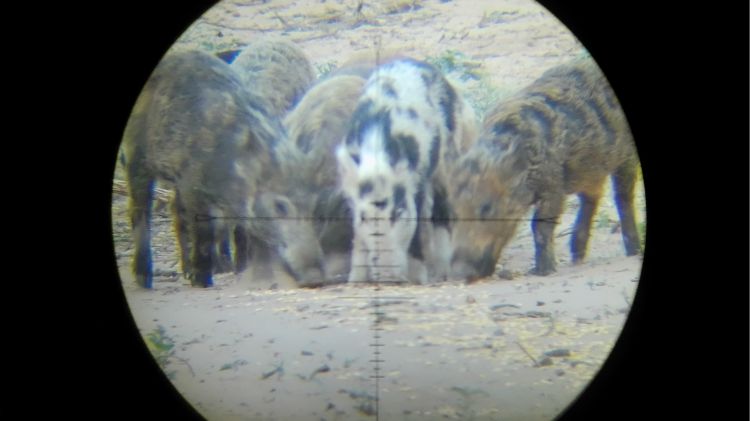Think about the last hunt you were on, stalking the woods in search of squirrels; moving slowly and quietly along a trail, whilst scanning the canopy for a glimpse of fur fluttering in the wind. You see your quarry, and use whatever cover is available to move into range, finally reaching a spot where you can settle into a stable shooting position. After mounting the rifle and lining up the crosshairs, you squeeze the trigger and bag the first squirrel of the day.
Now imagine the same scenario, but you are trying to film the hunt. The level of difficulty has significantly increased because working the camera takes more time, draws attention away from the main task, and requires more movement. The need to capture photos or video greatly increases the odds of failure and this is compounded by potential technical issues; cameras that won’t turn on or inexplicably shut down, go out of focus, are improperly configured for changing light conditions, run out of battery power, have memory cards that fill up during filming, or cards that become corrupted.
It can be quite a letdown when, after a successful hunt, you find that the footage was either not captured or unusable for one reason or another, but assembling the right camera gear and learning how to use it will improve your results when filming your hunting. This sounds obvious and simple, but it has taken me years to sort out my camera gear and learn how to get the most out of it.
 Which cameras are best for filming hunting?
Which cameras are best for filming hunting?
My hunting cameras can be grouped into three categories;
- action cameras
- scope cameras
- DSLR cameras
I have found that different cameras work better for specific applications and recording tasks. In general, I use action cameras for B-roll, when on the move through the woods, for instance. Scope cameras work especially well in situations where setting up a tripod with a DSLR or videocam is not practical. I use DSLR cameras as my primary tool for both photography and video recording. Of course, these are general rules of thumb, and there is a lot of cross-over. It is fair to say that my pack often contains more camera gear than anything else, and the mix of gear changes depending on the hunt.
Action cameras are generally compact and lightweight units; they can stand up to physical abuse, have flexible mounting systems, and can capture high resolution (4K) video at high frame rates. They have recording features such as slow motion and timelapse that are not frequently used, but are an asset when needed.
Dual screen cameras (GoPro Hero & DJI Action Camera)
At the present time I am using a GoPro Hero (versions 7, 8, and 10). These cameras produce excellent video quality that, when set in cinematic mode with linear FOV, dovetail nicely with video captured using DSLR and videocams. The ability to control multiple cameras with a smart phone app can also be quite useful, but on the downside, the GoPros have limited magnification, mediocre low light performance, the native audio is less than stellar, and they don’t perform very well in extremely cold temperatures.
I also use the DJI Action camera, which provides excellent image quality and was the first action cam with a dual screen. This functionality allows either screen to be used when framing a shot and is quite useful for vlogging-type applications.
It is true that there are newer versions of the GoPro with the dual-screen feature, but the DJI is compact, reliable, tolerates cold weather, and has decent low-light performance at a great price. I also use the DJI Osmos Pocket, which strictly speaking is not an action camera, but rather a small camera that uses an action-camera type sensor and control system with an integrated mechanical gimbal.
 Scope cameras (Tactacam)
Scope cameras (Tactacam)
The real game-changer in my outdoor video production capability has been the incorporation of various scope cams. These cameras attach to a scope using a mounting assembly that incorporates a series of mirrors that direct light to the ocular lens of the scope, whilst diverting some percentage to the lens of the camera affixed to the mount. There are variations on how the mirrors are arranged, which camera systems are used, and how the scope cam is mounted on the scope. The latter is an important factor when selecting a camera because some devices work better for certain scope designs whilst being unsuited for others. I currently use three devices on a regular basis.
Recently I’ve been using cameras manufactured by Tactacam, a company focusing on products for the hunting and fishing community. These generate excellent image quality, have a great user interface for controlling multiple cameras, provide a very long battery life, and the new version 6.0 incorporates a 10x magnification. The value of these features is enhanced with mounting systems specifically designed for mounting on a rifle barrel or on Picatinny rails.
Using GOPRO CAMERAS with a riflescope
The SideShot mount incorporates a GoPro Backbone camera and was the first through-scope device I used. It comprises a tubular extension of the eyepiece that attaches to a clear plastic camera case, by way of a horizontal tube in which mirrors are positioned. Two arms, affixed to the eyepiece extension, are attached to the scope by rings that grip the scope tube. These rings have two brackets into which the arms are slotted and held in place. Rings are available for several tube diameters, and this system provides a very secure attachment between scope and camera. This rig works well on most scopes, so long as there is room for both the camera ring and the conventional scope ring to fit. However, some compact scopes do not have enough space between the turrets and magnification ring to mount both.
There are various options for GoPro cameras used in this system, and also an adaptor for a smart phone, although I can only speak to the GoPro Backbone version I am using. In my experience this camera is both the strength and weakness of the rig; the image quality can be exceptional, slow motion can be impressive, and it shares batteries with the other GoPro products I use.
I think that if recording at fixed distances and in good light conditions – not too bright or too dark – the output can be brilliant, but when light conditions change, or the target moves and the scopes focus or AO needs to be altered, the output quality is less predictable. The camera can be dialled in for these changed conditions, but requires the phone app to be opened and connected, and the camera reset. This takes a long time, and in my experience, is not always possible.
 Riflescope attachments for cameras
Riflescope attachments for cameras
The UK-produced EagleVision scope camera has earned a place in my gear rotation. Mine uses a GoPro Hero 7 with a 12mm lens sourced from EagleVsion. A modified Hero 7 with this lens costs significantly less than the Backbone, and I think works better in this application. This system is also available with attachments for various cameras and smartphones. The housing fits directly over the ocular lens and is locked down with a ring clamp to hold the device securely in place. The output with this system is similar to the SideShot, which makes sense because it is based on the GoPro, and it can produce spectacular images. However, it comes with the same limitations noted above, it is finicky and takes time to adjust in the field. It is perhaps a little better in low light, but still not great and, as with all GoPros I’ve used, the battery life is short and the cold weather performance is problematic.
The design of this device allows it to be mounted on a short scope tube, but because the mount slips over the ocular lens, if there is an illumination control located on the eyepiece, this mount cannot be used. As long as you consider these mounting constraints when setting up your rig, either of these systems can offer a secure fit to your hunting rifle.
 Preventing blurred images from hunting cameras
Preventing blurred images from hunting cameras
The problem I had with both the SideShot and the EagleVision were related to the GoPro cameras, and not the mounts themselves. Looking back at past videos I noted there was a significant volume of hunting footage that couldn’t be used because of blurred images. Undoubtedly, the cameras could have been adjusted, but I usually don’t have time when hunting to pull out my phone, open an application, and adjust the scope/camera.
Recently, I’ve been using the Tactacam FTS mount matched up with their 5.0 UltraHD camera. Like the EagleVision, the FTS mount slides over the ocular lens, but due to the cylindrical shape of the camera, it is more compact than other devices. The camera provides easy access to integrated controls and uses batteries with a long life that can be changed without removing the camera from the mount.
There is a small and easy to use remote that can control several cameras. I will set up a Tactacam action camera focusing on me, one over my shoulder, then the FTS scope mounted camera on my rifle, and with one push of a button all three cameras fire up together. As with the GoPros, there is a phone app that can be used to configure, monitor, and control the cameras, that features an intuitive and easy to use interface.
The best cameras for filming hunts
After a lot of field time, the Tactacam FTS is my preferred scope camera. In all fairness, the GoPros offer more control over the image, and when everything is perfectly set and the conditions ideal, probably produce the best image quality, but the Tactacam images are very good, and once the camera is dialled in, it doesn’t seem to be negatively impacted by changes to focus or the AO setting. This camera works better in low light conditions, but it is also fast and easy to implement presets for specific light conditions.
For general videography I use a Canon Ti6 DSLR or a Sony Alpha 6 Mirrorless DSLR. The advantages of these cameras are that the cinematic image quality can be superb, it is easy to adjust the depth of field, interchangeable lenses can be used, and the audio quality is very good on both cameras. However, I find that (my) DSLRs don’t have a smooth auto-focus function and are less suited to filming under pressure whilst trying to set up and place a shot on game. I use DSLR cameras for recording interviews, discussing gear, or generating glamour shots of guns. When mounted on a tripod with a telephoto lens, it is also great for wildlife videography, and of course, it’s always available for still photos!
Filming a hunt is intrusive and makes the whole process more difficult. Little things that don’t seem important when sitting behind your laptop researching cameras can be deal-breakers in the field. If you must access a phone app for a simple adjustment or remove the camera from a housing to change batteries or a memory card, it will result in lost opportunity. This collection of action cams, scope cams, and DSLRs are the cameras that have worked best for me when filming my hunts, after a lot of trial and error. Having said this, I am constantly on the lookout for the next level of camera gear with the hope that someday I’ll be able to forget I’m recording and focus on hunting!